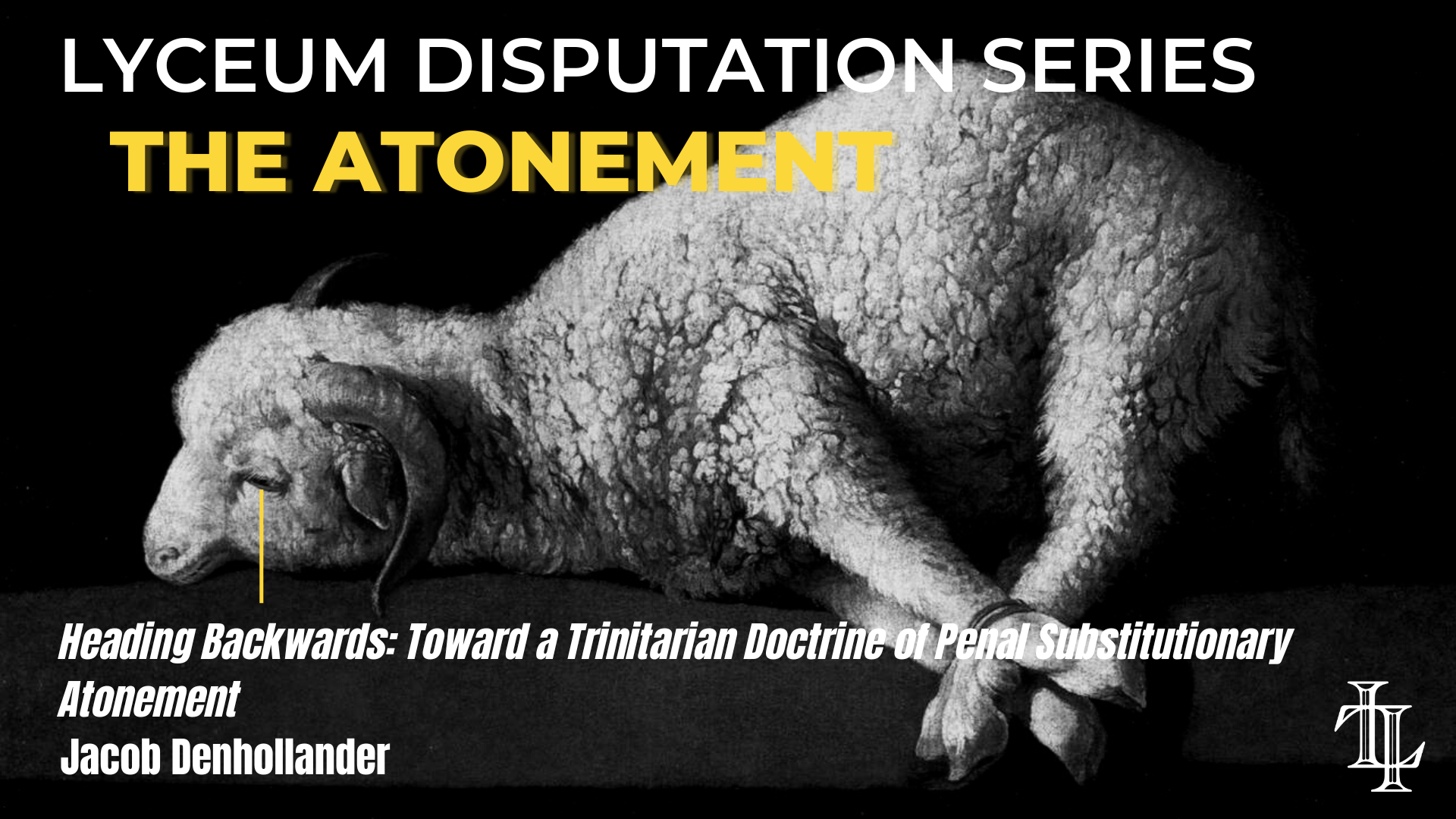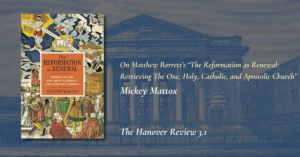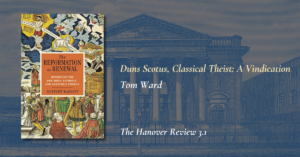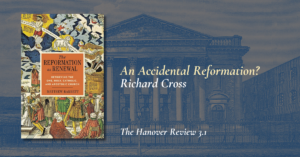Editor’s Note: This is the final summary of our Lyceum Disputation series considering the necessity of Penal Substitutionary Atonement as described in this 2017 SBC resolution. As with all our work, the London Lyceum publishes a range of viewpoints to encourage thinking.
The opinions about Penal Substitutionary Atonement (PSA) presented in this series have been varied. Joshua McNall and Adam Johnson argued that while Biblical evidence seems to point to some version of PSA, they expressed concerns that many harmful or unwarranted entailments are often included in some articulations of PSA. Even for these writers who are generally advocates of PSA, there was a feeling that much work remains to be done in terms of articulating, defining, and properly situating PSA in the atonement discourse. Jonathan Rutledge posed serious questions about the logic of retributive justice upon which many versions of PSA rest. Carl Mosser disputed the claim that PSA is the historical Baptist explanation of atonement, argued that an insistence on PSA was unnecessarily divisive and that a modern form of the doctrine owes much to the influence of John Owen over against the more mild form found in the writings of Calvin. Benjamin Wheaton examined modern claims that PSA is the foundation of other key atonement themes and argued that when compared to historical data, this claim is exactly backward. Finally, writing from a Roman Catholic perspective, Joshua Thurow wrote that while substitution is a valid biblical theme, penal substitution has the tendency to distort our understanding of God’s justice. If a consensus has emerged, it is that there is no general consensus about PSA.
However, while we here at the London Lyceum are happy to host a variety of opinions to broaden our understanding and foster charitable debate, our own perspective is confessionally Baptist. Although the words “penal substitutionary atonement” do not appear in the 1689 London Baptist Confession of Faith (1689 LBCF), the doctrine is clearly presented in a number of places. This confession we “cheerfully confess” states that on the cross, Christ “really and fully satisfied God’s justice” on behalf of all who are justified, enduring “in their place the penalty they deserved.”[1] While the 2017 resolution we have been considering in this series, “On the Necessity of Penal Substitutionary Atonement,” appeals to the language of the Baptist Faith and Message 2000 to support its case that PSA is an essential doctrine, the BFM 2000 only goes so far as to affirm that Christ’s substitutionary death made provision for the redemption of men from sin (II.B). Thus, holding to the 1689 LBCF commits one to a penal substitutionary atonement, whereas holding to the BFM 2000 does not entail affirming that Christ’s death satisfies God’s justice. While it may be the case, then, that one can be a Southern Baptist without affirming PSA, one cannot be a Particular Baptist without affirming PSA.
All that to say, as a Particular Baptist, I gladly affirm PSA, and am heartened to see Southern Baptists continue to hold to and promote the doctrine. Despite this, I have serious reservations about the helpfulness of the 2017 resolution. As the resolution itself notes, PSA has come under serious scrutiny in recent decades; unfortunately, the defense mounted in the resolution does nothing to address these criticisms. In this essay, I argue that it is not enough that PSA is presented, but that it must be presented in a particular manner. I will do this by comparing and contrasting the way the 2017 resolution presents the doctrine with the way the 1689 LBCF presents the doctrine, arguing that the explicitly Trinitarian approach of the latter should serve as our model.
Creating or Solving Problems? Modern Perspectives on Penal Substitution.
At the outset, it must be acknowledged that such a comparison is somewhat of an apples-to-oranges situation. The 1689 is more robust and theologically holistic, whereas the 2017 resolution is not intended to be as theologically comprehensive and is somewhat limited by its form as a connected series of “whereas” statements. Yet even the existence of these differences in form point to distinct ways of approaching the doctrine.
In the first three “whereas” statements of the resolution, we are presented with the raison d’etre of the resolution: numerous Protestant voices have labeled PSA a monstrous doctrine that is indicative of “the Father murdering a son” in an attempt to recast the atonement as a basis for pacifism. The seeming identification of pacifism as the driving force behind the objections to PSA is, in my opinion, artificially narrow. Certainly, some pacifist theologians like Darrin Belousek have argued against penal theories on this basis,[2] but objections to PSA along these lines are by no means limited to pacifist theologians. Feminist theologians have been explicitly arguing that PSA represents abusive dynamics since the late 1980’s—Rita Nakashima Brock’s evocative phrase describing atonement as “cosmic child abuse” has come to be seen as particularly applying to penal theories of atonement.[3] Variations of this critique have become so ubiquitous that penal substitutionary and other satisfaction theories have been discarded by many contemporary theologians in a search for less problematic models. And, pacifist or not, certainly any Christian should be squeamish about a description of the cross in which the “Father murders the Son.” However, having identified these objections to penal atonement, the resolution does nothing to address them or show how this is a false representation of PSA. Instead, it goes on to simply assert that despite these objections, PSA is biblical and essential. One is left with the impression in reading the resolution that the resemblance to “divine child abuse” is simply a hard truth that must be accepted in obedience to what God has revealed in Scripture.
What is curious about this is that scholars who have defended PSA have long recognized that the doctrine of the Trinity answers the “cosmic child abuse” objection quite readily. In short, since the doctrine of the Trinity teaches that God is one in will and that all of his actions in the economy are inseparable operations of all three, it cannot be the case that at the cross the Father acts against the Son for the Father’s own purposes, which it should be said, would be a form of unjust abuse. Yet, even with the accusation of “cosmic child abuse” hanging in the air, the doctrine of the Trinity is not explicitly mentioned nor even implicitly appealed to in the resolution. One looks in vain for any mention of the third person of the Trinity. While Southern Baptists strongly hold to the doctrine of the Trinity, on the evidence of this resolution, it seems that on this occasion they did not see it as a necessary part of articulating the “burning core of the gospel.”
While it is understandable that a resolution focused on affirming a certain doctrine would primarily focus on that doctrine, this resolution goes beyond that. In effect, it presents PSA as an isolated doctrine that stands or falls on its own and presents it as the “only hope of a fallen race.” This presentation is different from how the doctrine is presented in earlier Reformed and Baptistic creeds. The differences in presentation are not merely cosmetic or superficial but alert us to the fact that we are in fact dealing with two different doctrines that, whilst going by the same name, are different in important ways. In an essay earlier in this series, Carl Mosser argued that the version of PSA assumed in the resolution has as its focus the outpouring of God’s wrath. That is, the way in which God’s wrath is satisfied is in the expression of the wrath. The Father spends his wrath on the Son instead of sinners, and in this way his wrath is satisfied. This can be seen in the phrase that at the cross the “perfect love of God perfectly applies the perfect justice of God to satisfy the perfect holiness of God” and that denying PSA robs God of the “exercise of his justice,” that is, “the outpouring of His just retributive wrath.”[4] In other words, the way Christ saves us is by passively absorbing wrath (and even hatred) directly from the Father as the object of God’s displeasure. In order to distinguish this form of PSA from other forms, I call this “Trinitarian Schism penal substitutionary atonement.”[5] A very clear and stark example of a Trinitarian Schism variant of PSA is found in the introductory-level work What is the Gospel? by SBC pastor Greg Gilbert. In this little book that has sold over 250,000 copies, Gilbert writes that at the cross, the Father “looked at his Son, saw the sins of his Son’s people resting on his shoulders, turned away in disgust, and poured out his wrath on his own Son.”[6] And, just like the resolution, while Gilbert identifies the “divine child abuse” objection, he does not point to Trinitarian realities as answering this objection. Instead, he simply declares that “to toss substitutionary atonement aside is to cut out the heart of the gospel.”[7] Accepting the resemblance to cosmic child abuse is apparently accepted as a necessary consequence of believing the Gospel. While this is repulsive in itself, it is not even the biggest difficulty the Trinitarian Schism variant runs into. Looming even larger is the question of whether it is even coherent to speak of the Father unilaterally doing something to the Son. Is the cross a place where the Trinity ceases to act in a Trinitarian way, with God acting against God to save sinners?
Whose Fault Is It, Anyway?
It is this last question that leads me to disagree with Mosser’s assessment that this form of PSA is to be blamed on the influence of John Owen. It is true that Owen does occasionally use language that could be seen to endorse this view. In one of his earliest writings on the atonement, The Death of Death in the Death of Christ, Owen writes that “the Lord Christ, (if I may say so) was sued by his Father’s justice unto an execution.”[8] A little further, Owen writes that “Christ underwent not only that wrath (taking it passively) which the elect were under, but also which they should have undergone had not he borne if for them.”[9] However, these isolated statements should be read against a trajectory of consistent Trinitarian thinking that does not see the cross as something the Father subjected the Son to, but something that the Father and Son and Spirit accomplished to satisfy the justice common to them. While it is true that Owen did develop his idea contra the Socinians that God must act justly to see that sin is punished, this was balanced by his conviction that justice was common to Father, Son, and Spirit by virtue of their shared nature. Thus, Christ does not exhaust the anger of the Father at the cross, but instead satisfies the justice of God. It is worth noting the subtle difference that can be seen between the Savoy Declaration (and 1689 LBCF) and the Westminster Standards upon which it is based. The Standards declare that the obedience and sacrifice of Jesus “hath fully satisfied the justice of his Father,” whereas the former changes to read, “hath fully satisfied the justice of God.”[10] This reflects Owen’s conviction that justice is something that inheres in the nature of God and does not belong especially to any member of the Trinity.
In Owen’s more mature reflections on atonement, the son as passive recipient of wrath is nowhere to be found. Instead, Christ’s active mediation through the Spirit comes into full view. The cross is not a place where the Father acts as high priest by sacrificing his Son, but where the Son acts as high priest by sacrificing himself by the eternal Spirit (Hebrews 9:14). In his wonderful reflection on the Holy Spirit, Pneumatologia, Christ’s death is attributed by Owen not directly to God, but to “the most horrible wickedness that ever human nature brake forth into.” Nor is it the mere fact Christ endured the penalty under the law that is the means of our deliverance; instead, says Owen, “the voluntary giving up of himself to be a sacrifice in these holy acts of obedience was that upon which, in an especial manner, God was reconciled unto us.”[11] In this version of PSA, the Triune God’s justice is satisfied when the Son suffers the penalty of death required under the law at the hands of desperately wicked men, but without proposing or even allowing that the Father unilaterally acts directly against the Son. It is the Son’s obedience in our place as covenant head that is decisive for our salvation, not the Son’s ability to act as an infinite receptacle of the Father’s infinite anger.
The Modern Influences of Modern PSA
If Owen’s Trinitarian theology does not suggest a Trinitarian schism, what is the fountainhead of its nearly ubiquitous presence in evangelical presentations of PSA? While it is difficult to pinpoint with complete accuracy a single source of any given theological trend (as if such a thing exists!) the idea that at the cross the Father is set in opposition to the Son calls to mind not John Owen but a much more recent theologian, Jürgen Moltmann. While Moltmann was not an advocate of PSA, he did place the cross at the center of his theology to such a degree that the cross event constitutes God’s identity.[12] Answering the question, “Why did Jesus die?” Moltmann answered that ultimately Jesus died because of “his God and Father.”[13] This is not merely a reference to God’s eternal covenantal purpose, but rather, that the cross is something that “took place between Jesus and his God, and between his Father and Jesus.” Moltmann does not simply mean that Father and Son were both active at the cross—“The abandonment on the cross which separates the Son from the Father is something which takes place within God himself; it is stasis within God—‘God against God.’”[14] A little further, Moltmann writes that Christ “died as one rejected by his God and Father…It is this alone which distinguishes his cross from the many crosses of forgotten and nameless persons in world history.”[15] For Moltmann, this enmity and rejection is most profoundly seen in Jesus’ cry on the cross, “My God, My God, why have you forsaken me?” (Matt. 27:46, Mk. 15:34), which he took to indicate a real change in status between Father and Son. All theology, he wrote, is an attempt to answer Christ’s question.[16]
It would take many more pages to give a full accounting of Moltmann’s theology, which is deeply concerned with what God’s self-identification with suffering means in a post-Holocaust world. What is important for our purposes of comparison and contrast is that it is Moltmannian logic, not classical Reformed theology, which gives rise to the rhetoric of “God against God” and even, I suspect, the identification of the atonement as the “heart of the Gospel.” It is important to note here that Moltmann rejected classical ideas of the Trinity and God’s impassibility as he felt they stood in the way of understanding God’s relationship to fallen humanity. It is no wonder, then, that adopting this rhetoric of the cross leads to difficulties for those who attempt to hold it in conjunction with classical Trinitiarian commitments and a commitment to PSA. At best, it results in inconsistency and confusion. At worst, it produces a way of speaking about the cross that has every appearance of “cosmic child abuse.”
Confessional Penal Substitutionary Atonement
While the modern evangelical theology represented in the 2017 resolution declares PSA as “the only hope of a fallen race,” the 1689 LBCF[17] identifies a different ground: It is the doctrine of the Trinity that is “the foundation of all our communion with God, and comfortable dependence on Him.”[18] There is an implicit and explicit Trinitarian theology that runs throughout the confession and drastically shapes the presentation of PSA. The confession does not have a chapter on “the atonement;” rather, the discussion of the atonement primarily takes place in chapter 8, “Christ the Mediator.” One thing that distinguishes the 1689 and other Reformed confessions is the covenantal framework in which it presents Christ’s work. It not only concerns the covenant relationship between God and his people, but also “the eternal covenant transaction that was between the Father and the Son about the redemption of the elect” which is the foundation for all of God’s redemptive activity.[19] This eternal covenant is identified in paragraph 1 of chapter 8 as the basis for Christ’s appointment as mediator between God and man. This is not a unilateral decision of the Father, but a work the Son “did most willingly undertake”[20] not as a junior member in a partnership but as “the second person of the Holy Trinity, being very and eternal God, the brightness of the Father’s glory, of one substance and equal with Him who made the world,[21] who upholds and governs all things.”[22] It is within the context of Christ’s mediatorial work that his death on the cross is first mentioned, and it is clearly a penal substitutionary view—Christ discharged his duty under the law, fulfilling it on our behalf and undergoing the punishment due to us. However, Christ’s suffering and death in our place is in the same paragraph listed with his resurrection, ascension, intercession and coming return. In short, PSA, while central to the theology of the confession, never takes on an identity of its own outside of the entirety of Christ’s person and work.
The following paragraph is vital. In it, Christ is said to have fully satisfied the justice of God. How has he done this? Recall that the 2017 resolution states that the holiness of God is satisfied when the justice of God is applied at the cross. In contrast, the confession states that the justice of God is satisfied by Christ’s “perfect obedience and sacrifice of himself, which He through the Spirit once offered up to God.”[23] This active fulfillment of justice through willing sacrifice is echoed in Chapter 9.3, where Christ is said to have made a “proper, real, and full satisfaction of God’s justice” by “the sacrifice of himself in the blood of his cross.” Never in the confession is it implied that the Father subjects the Son to death. Rather, the Son is portrayed as obeying and suffering the penalty of the law as a self-giving sacrifice. Yet he does not do this on his own independent of the Father or the Spirit.
Why did Christ die? According to the confession, the answer is that Christ died under the law as part of his mediatorial work to satisfy the justice of God, which work he accomplished willingly through the Holy Spirit in keeping with his own purposes expressed in the eternal covenant between him and his Father. The rich covenantalism, language of sacrifice, and Trinitarian affirmations do not allow us see the persons of the Godhead at odds with one another at the cross, and even less to see traces of “cosmic child abuse.”
Conclusion
This summary has barely scratched the surface of a much larger discussion about Christ’s atoning work—a discussion that will no doubt continue until our Lord returns. However, what we have seen is that it is not always necessary to present people with the dichotomy of either accepting an unpalatable doctrine or rejecting the gospel. It is true, of course, that some will reject the truth as unpalatable because they do not want to accept it. However, we should also be open to the idea that they sometimes reject the truth because we have been presenting it in a truly unpalatable way. Such is often the case, I believe, with PSA. Our forebears have shown us a better way. We would do well to heed their example.
[1] Stan Reeves, ed., The 1689 Baptist Confession of Faith: In Modern English (Cape Coral, Florida: Founders Press, 2017), 29 (11:3).
[2] See Darrin W. Snyder Belousek, Atonement, Justice, and Peace: The Message of the Cross and the Mission of the Church (Grand Rapids: Eerdmans, 2012).
[3] Rita Nakashima Brock, Journeys by Heart: A Christology of Erotic Power (New York: Crossroad, 1988), 56; Rita Nakashima Brock, “And a Little Child Will Lead Us,” in Christianity, Patriarchy, and Abuse: A Feminist Critique, ed. Joanne Carlson Brown and Carole R. Bohn (New York: The Pilgrim Press, 1989), 52.
[4] “On The Necessity Of Penal Substitutionary Atonement,” https://www.sbc.net/, June 1, 2017, https://www.sbc.net/resource-library/resolutions/on-the-necessity-of-penal-substitutionary-atonement/.
[5] Joshua Farris and S. Mark Hamilton have proposed the sobriquet “Christus Odium” to describe this version of PSA. However, there may be versions that do not require the Son to be the object of the Father’s hatred per se while still maintaining that at the cross the Father acts against or upon the Son in some fashion to satisfy his wrath. Hence, ” Trinitarian Schism.” See, Joshua R. Farris and S. Mark Hamilton, “This Is My Beloved Son, Whom I Hate? A Critique of the Christus Odium Variant of Penal Substitution,” Journal of Biblical and Theological Studies 3, no. 2 (2018): 271–86; Joshua R. Farris and S. Mark Hamilton, “Which Penalty? Whose Atonement? Revisiting Christus Odium,” Journal of Biblical and Theological Studies 6, no. 1 (2021): 5–20.
[6] Greg Gilbert, What Is the Gospel?, 9Marks Series (Wheaton, IL: Crossway, 2010), 67.
[7] Gilbert, 67 It is worth noting that this language precedes that of the resolution by some 7 years.
[8] John Owen, The Death of Death in the Death of Christ (Edinburgh: Banner of Truth Trust, 2007), 173.
[9] Owen, 173.
[10] See Westminster Assembly, The Westminster Confession of Faith: Edinburgh Edition (William S. Young, 1851), VIII.5; and the Savoy Declaration, Philip Schaff and David Schley Schaff, History of the Christian Church (Charles Scribner’s Sons, 1910), VIII.5.
[11] John Owen, “Πνευματολογια, or a Discourse Concerning the Holy Spirit,” in The Holy Spirit, ed. William H. Goold, vol. 3, The Works of John Owen (Edinburgh: T&T Clark, 1966), 180.
[12] For a short overview of Moltmann on this point, see Thomas H. McCall, Forsaken: The Trinity and the Cross, and Why It Matters (Downers Grove, Ill: IVP Academic, 2012), 15–18.
[13] Jürgen Moltmann, The Crucified God, 40th Anniversary (Minneapolis: Fortress Press, 2015), 216.
[14] Moltmann, 221.
[15] Moltmann, 221–22.
[16] Moltmann, 224.
[17] As far as I am aware, the presentation that follows is also generally true of the Westminster Confession of Faith and the Savoy Declarations, though differences of wording or emphasis might need to be explained. However, I am appealing to the explicit wording of the 1689 LBCF because it is the confession we promote.
[18] Reeves, The 1689 Baptist Confession of Faith, 2.3.
[19] Reeves, 7.3.
[20] Reeves, 8.4.
[21] cf. paragraph 4.1, which names the Triune God—Father, Son, and Holy Spirit—as the creator of the world.
[22] Reeves, The 1689 Baptist Confession of Faith, 8.2.
[23] Reeves, 8.5.
Author
-

Jacob Denhollander lives in Kentucky with his wife Rachael and four kids and is a member of the Reformed Baptist Church of Louisville



